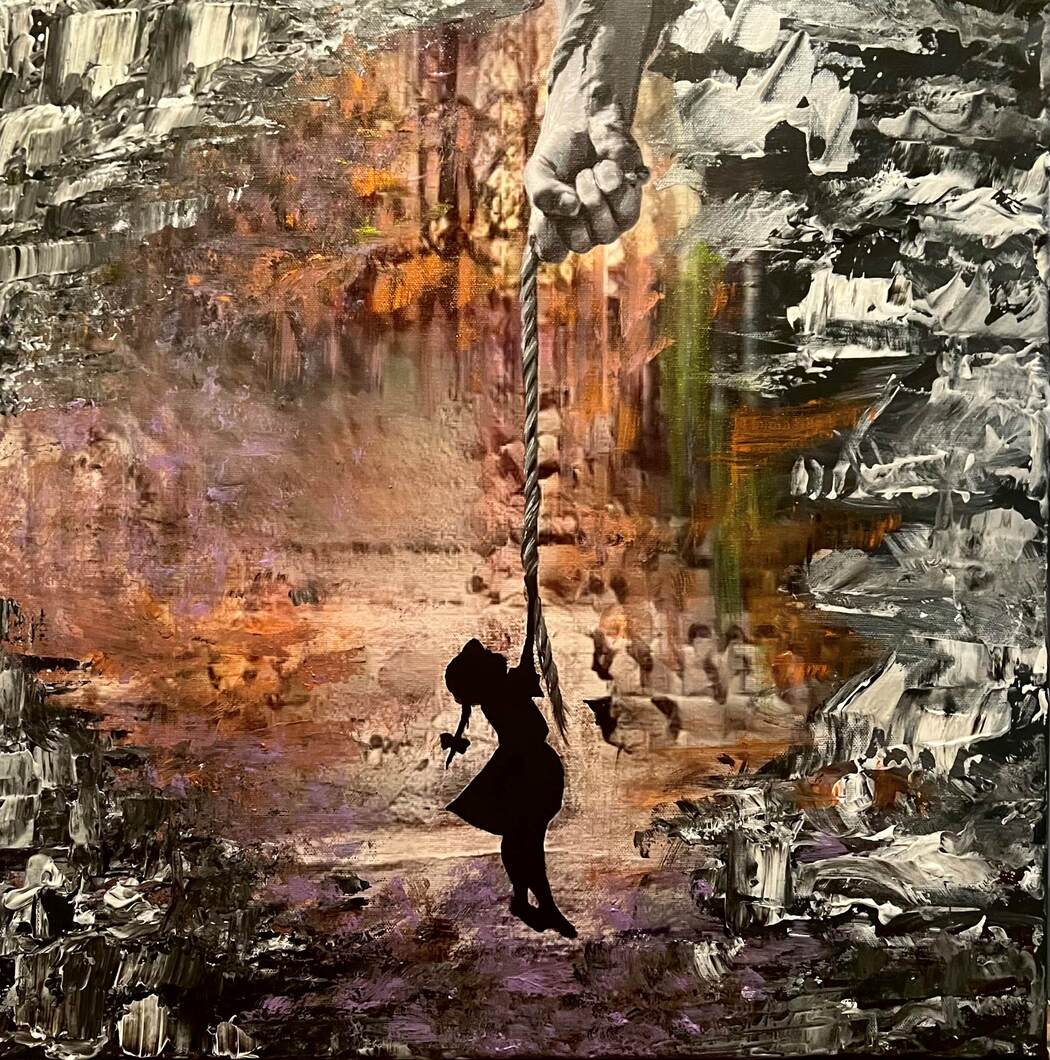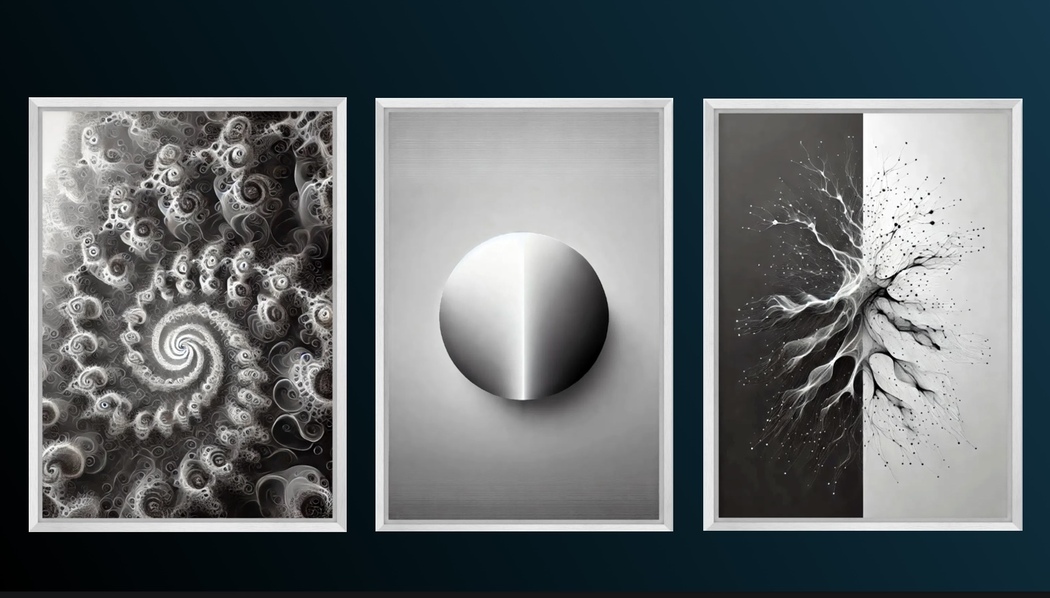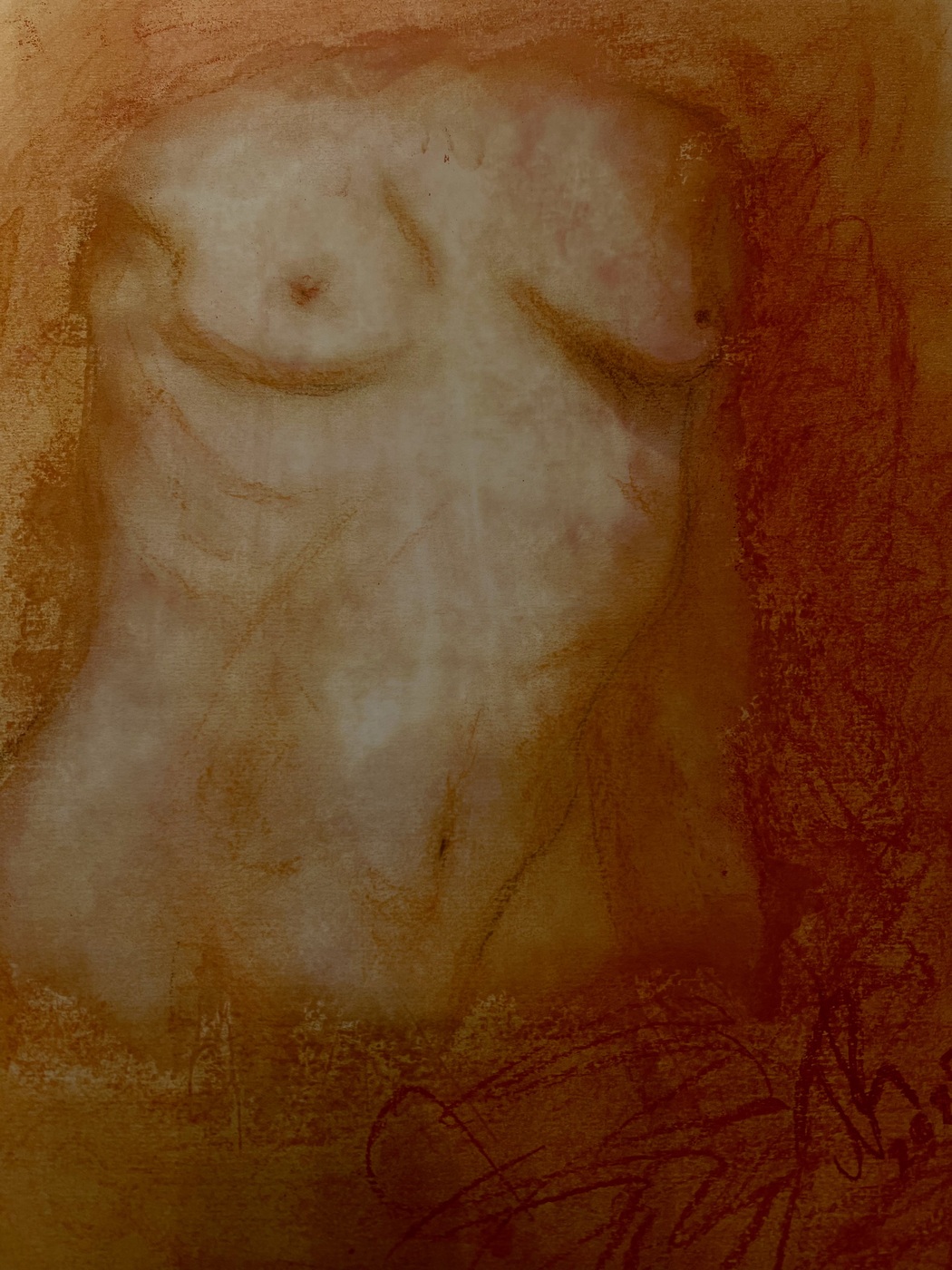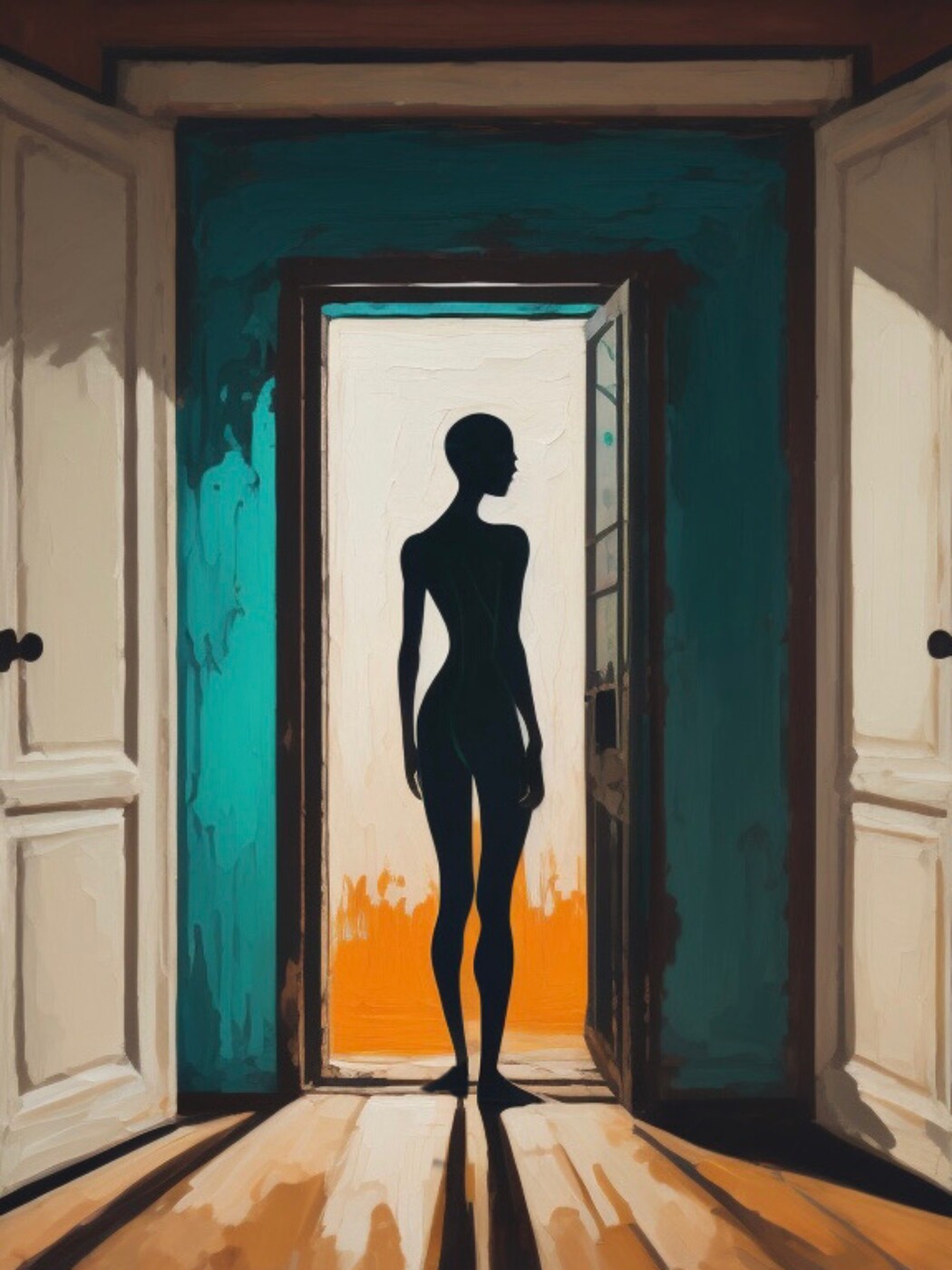Natalya Raduenz
Year of birth: 1980
Where do you live: Germany, Toenisvorst
Your education: Higher engineering degree, MBA
Describe your art in three words: Transformation. Contemplation. Resonance.
Your discipline: Metamodernism, conceptual painting, iconography
Website | Instagram
Your art is described as a testimony of overcoming challenges. Can you talk more about the process of healing through your paintings?
My art is not just creativity; it is a process of healing, a transformation of pain into something greater than mere memories. Every brushstroke, every line carries traces of lived experience, but what matters most is that I consciously reshape this experience, giving it new life.
I believe that art can be a bridge between the past and the future, a way to reinterpret even the most painful moments. In my case, it was a struggle with childhood trauma, fears, and self-doubt. When I paint, it feels like an internal dialogue—fear and pain come to the surface, not to consume me again, but to become part of something bright and meaningful.
Sometimes this process unfolds through chaos—mixed techniques, expressive brushstrokes, unexpected color combinations. Other times, it is a meditative immersion, like in icon painting, where every element demands absolute concentration and inner stillness. In any case, each piece is my path to freedom, to the ability to embrace myself and the world without masks.
My paintings resonate with people because many of us fight our own battles, even if they remain unseen. I want my works to carry hope, for the viewer to look at them and feel: even through pain, something beautiful can be created. After all, art is not just a reflection of reality—it is the power to transform it.
 Natalya Raduenz | God’s hand | 2024
Natalya Raduenz | God’s hand | 2024
How do you merge your background in engineering with your artistic expression? How does this dual perspective influence your artwork?
My engineering background and artistic creativity are two poles that, at first glance, seem opposing but, in reality, create the tension and balance essential to my art. They are like two energies—one structured, logical, and analytical, the other intuitive, emotional, and chaotic. They complement each other, allowing me not only to follow traditions and techniques but also to experiment, explore new forms of expression, and find harmony between calculation and spontaneity.
Engineering teaches me discipline, precision, process structuring, and working with materials and technological aspects. These skills help me approach art with a focus on craftsmanship, attention to detail, and quality.
On the other hand, art is a space for emotional expression, exploration, and experimentation, where the process itself is just as important as the outcome. Here, my engineering logic encounters the intuitive, sometimes chaotic nature of creativity. The idea of balancing the technical and the artistic—necessary for a deeper understanding of reality—is reflected in my new series, “The Echoes of Infinity,” where I explore the intersection of science, philosophy, Christianity, and art.
Inspired by Descartes’ dualism, the Holy Trinity of the New Testament, and Duchamp’s concept of the “infra-thin,” I reveal the subtle transitions between opposites. Here, mathematics becomes a language for seeking truth, while philosophy serves as a tool for understanding its multilayered nature. Through the principles of the golden ratio and quantum physics, the series demonstrates that truth does not lie in extremes but in their interaction.
This is a visual metaphor of consciousness, where chaos and order do not merely coexist but form a dynamic unity. In this concept, reality is no longer static—it becomes an infinite process of awareness, where art acts as a mediator between rational knowledge and spiritual perception.
Thus, my engineering background allows me to bring elements of discipline, structure, and precision into art while preserving the freedom and emotional depth inherent in painting and creativity as a whole. My perspective as an engineer enables me to see and understand the structure underlying an artwork, but it is creative freedom that allows me to transform this perspective into something unique, merging logic with intuition.
 Natalya Raduenz | The Echoes of Infinity
Natalya Raduenz | The Echoes of Infinity
Could you elaborate on the concept of ‘Blind Paintings’? How does this approach shape the emotion and story behind your works?
Blind Paintings emerged at the early stage of my artistic journey. I have no formal academic training in fine arts, and my initial impulses to create were purely intuitive. I simply applied chaotic brushstrokes to the canvas without a predetermined subject, idea, or concept. Layer by layer, random lines and patches of color gradually formed into images, as if revealing themselves on their own.
This method became a way for me to communicate with my subconscious, to explore how chaos transforms into meaning. Viewers often see completely different things in these paintings—and that is no coincidence. Each person brings their own experience, their emotional history, which overlays the visual symbols encoded in the work. As a result, art ceases to be something definitive; it turns into a dialogue—between me and the viewer, between their subconscious and the hidden meaning within the painting.
Some abstract works, as well as figurative pieces like the “She could fly” series, were born from this process. The image of the girl did not appear immediately—at first, there were only chaotic strokes that gradually took shape. Only at the final stage of the work did it become clear that something was missing, that the space needed the presence of a girl.
Overall, for me, blind painting is a way to go beyond the boundaries of conscious thought, to let emotions manifest spontaneously, without rational control. It is a method that allows not only the artist but also the viewer to connect with something deep, something hidden within their own experiences. And I am no longer surprised when people, looking at the same painting, see different stories, find their own symbols, and feel precisely what resonates with them at that moment. Their subconscious enters into a dialogue with the artwork, bringing it to life with new meaning.
Your current projects, “I Am Origin” and “The Echoes of Infinity,” explore truth in the resonance between polarities. Could you explain what these series represent to you on a personal and artistic level?
Series “I Am Origin” and “The Echoes of Infinity” are two distinct yet interconnected artistic explorations that are deeply personal to me. They reflect my search for truth at the intersection of opposites, in the resonance between chaos and order, the physical and the metaphysical, reason and emotion.
“I Am Origin”
This series is an intuitive exploration of the primordial source, the very moment of life’s conception, and its sacred nature. It is a reflection on the body—not as a mere form, but as a vessel of energy, memory, and creation. My intention was to move away from literal corporeality and instead reveal the essence of connection, the mystery that cannot be expressed in words but can be felt. In these works, the body dissolves into mist, its forms barely perceptible, yet the presence remains tangible.
On a deeper level, this series speaks to the feminine principle, not in a mundane sense but in a sacred one. Here, feminine energy is not opposed to the masculine but unites with it, creating something third—the very act of creation, life, the birth of something new. In this fusion, the boundaries of individuality disappear, the “I” dissolves, leaving only the process itself.
This series is my return to the origins, to the understanding of the primordial nature of existence. It is an attempt to touch a moment that cannot be remembered, yet one that we all carry within us.
 Natalya Raduenz | Sketch for the I AM Origin project | 2025
Natalya Raduenz | Sketch for the I AM Origin project | 2025
“The Echoes of Infinity”
Unlike “I Am Origin,” where I explore the sacredness of life through the body, “The Echoes of Infinity” focuses on the interconnection of mind, matter, and higher order. This series engages with concepts of science, philosophy, religion, and art, examining them as parts of a unified system, where each polarity does not exist in isolation but rather in balance with its counterpart.
I have always been fascinated by the transitions between states, the moment when one thing transforms into another—chaos into order, light into darkness, matter into energy. Drawing inspiration from quantum physics and Descartes’ philosophy, I find truth not in extremes but in their resonance. In this series, existence is depicted as a process rather than a fixed state, and it is precisely this process that I strive to capture in my work.
On a personal level, “The Echoes of Infinity” is about breaking beyond conventional perception, finding structure within chaos, and realizing that the boundaries we consider absolute are, in fact, fluid. In this series, I incorporate the mathematical principles of the golden ratio and Fibonacci sequences to illustrate that even chaos follows a hidden order, and randomness contains structure.
Resonance Between the Series
Despite their differences in approach, both series explore the same fundamental idea: the search for truth in the union of opposites. “I Am Origin” looks inward, into the essence of life itself, while “The Echoes of Infinity” examines the endless motion of its existence. In the first, form dissolves in unity, while in the second, it reveals itself through structure.
These works are not just artistic explorations but a way of comprehending the nature of existence. They combine personal experience, philosophical inquiry, and scientific principles, transforming them into visual metaphors that invite the viewer not just to observe, but to feel, reflect, and discover their own meanings.
How has your Orthodox faith influenced your creative journey and the themes you explore in your art?
Orthodox faith is my spiritual foundation, the pillar that shapes my worldview and artistic journey. It has taught me to see the world differently—not just through physical forms, but through their deeper meaning, through the search for spiritual essence within the material.
Icon painting was my first step in this realization. While working on icons, I understood that art can be not just a means of expression but also a conduit to the transcendent, to something greater than the artist themselves. In iconography, mastery is not as important as the inner state, prayer, and concentration. This approach has also influenced my other series: even in my abstract works, I seek meaning beyond the visible, striving to convey intangible states, moments of transition, and spiritual experiences.
The “Echoes of Infinity” series is largely inspired by Orthodox philosophy—the search for harmony, the union of opposites, the transcendence of binary thinking. This resonates with the concept of the Trinity, where three hypostases are one yet distinct, and with the Orthodox perception of the world as a mystery—something that cannot be fully comprehended but can be approached through art, prayer, and contemplation.
My faith also shapes my approach to the creative process itself. I perceive it as co-creation with God, as a way of understanding both the world and myself. Even in my most personal themes, such as in the “I Am Origin” series, I reflect on life as a gift, on the body as a vessel containing something far greater than its physical form.
Thus, Orthodoxy does not limit my artistic exploration—on the contrary, it deepens it. It helps me see art as a bridge between the material and the spiritual, and creativity as a path leading to a fuller understanding of the world and of oneself.
 Natalya Raduenz | Propaganda | 2024
Natalya Raduenz | Propaganda | 2024
You have mentioned your art as a way of transforming pain into inspiration. What role does transformation play in your artistic practice?
Transformation is a key element of my art. It is not just an artistic method—it is the very process of creation, the essence of my work. I do not depict reality as it is; I process and reinterpret it, finding new meanings even in the darkest experiences.
For me, art is not an escape from pain—it is a path through it. I have lived through difficult experiences, and instead of locking those memories away, I translate them into a visual language, allowing them to take on a different form, a different energy. In this way, personal trauma transforms into a source of inspiration, a search for light that always exists, even in the deepest darkness.
This principle is at the core of many of my works. The pieces created as “Blind Paintings” were born from the chaos of intuitive brushstrokes, which gradually took shape and meaning. They are a symbolic reflection of how our psyche processes complex emotions—out of disordered sensations, images emerge; from fragments, a story unfolds.
“I Am Origin” is also about transformation: here, the physical body evolves into something greater—a symbol of the primordial energy of life. Meanwhile, in “The Echoes of Infinity”, I not only rethink personal experiences but also global philosophical ideas, searching for harmony in the clash of opposites.
Transformation in art is both a change in form and an inward journey—a process of experiencing emotions, reinterpreting the past. And through this process, something new is born—a new painting, a new meaning, a new self.
With your works being presented in several countries and private collections worldwide, how do you think cultural diversity impacts your work?
Cultural diversity has a profound impact on my art, expanding the horizons of perception and adding new layers of meaning. Working and exhibiting in different countries, I observe how the same artwork can be interpreted differently depending on the cultural context. This teaches me to see art not as a fixed statement but as a dialogue, where the viewer brings their own experiences, value system, and worldview.
For example, in Orthodox tradition, icon painting is a strictly canonical art form, whereas in Western culture, religious painting is often linked to the artist’s personal interpretation. In this distinction, I find an interesting balance: my works are rooted in tradition, yet they remain open to free perception, to the search for meanings beyond dogmatic frameworks.
The philosophical and scientific concepts I explore in “The Echoes of Infinity” will likely take on different meanings in various cultural settings. Some audiences may perceive them as a reference to Eastern philosophies of unity and balance, while others may relate them to Western rationalism and the idea of dualism. This diverse reception makes me reflect on universal themes that transcend cultures, language, and traditions.
At the same time, cultural diversity influences the technical aspect of my work. Drawing inspiration from Byzantine iconography, European painting, and conceptual art, I find points of intersection, creating something unique that goes beyond the boundaries of a single style or school.
Ultimately, my art emerges at the intersection of tradition and modernity, personal experience and universal themes, the local and the global. Cultural diversity has become an integral part of my artistic language, expanding the way I understand the world and how I express it in my work.
 Natalya Raduenz | Run | 2024
Natalya Raduenz | Run | 2024

Leave a Reply